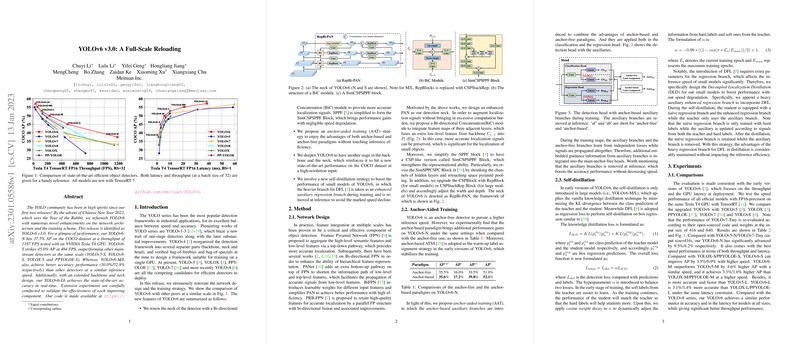An Analysis of YOLOv6 v3.0: A Full-Scale Reloading
The paper "YOLOv6 v3.0: A Full-Scale Reloading" presents significant advancements in the development of the YOLO (You Only Look Once) family of object detection models, known for their superior balance between speed and accuracy. The authors detail the enhancements in network architecture and training strategies that characterize YOLOv6 v3.0, as demonstrated through empirical evaluations on the COCO dataset. This version shows noteworthy improvements over its predecessors and competitors in the field of real-time object detection.
Network Design Enhancements
The authors introduce several key modifications to the YOLO architecture to enhance performance. The YOLOv6 network incorporates a Bi-directional Concatenation (BiC) module in the neck of the architecture, which integrates feature maps across adjacent layers. This adaptation is critical for retaining accurate localization signals, particularly for detecting small objects. Additionally, the SimCSPSPPF block, a simplified variant of SPPF, is employed to improve representational capacity with minimal degradation in speed.
The design enhancements extend to anchor-aided training (AAT), which marries the benefits of anchor-based and anchor-free paradigms. This integration results in improved performance without impacting inference efficiency, as the auxiliary branches are utilized during training but removed during inference.
Training Strategies: Self-Distillation
A self-distillation strategy is also employed, which significantly boosts performance, particularly for smaller models. This technique involves utilizing enhanced auxiliary regression branches during training, which are later removed for inference to maintain speed. The approach incorporates Decoupled Localization Distillation (DLD), specifically for small models, ensuring efficiency is maximally retained without compromising accuracy gains.
Performance Evaluation
The YOLOv6 models exhibit impressive numerical results across various configurations:
- YOLOv6-N achieves 37.5% Average Precision (AP) at a throughput of 1187 FPS.
- YOLOv6-S attains 45.0% AP at 484 FPS.
- Larger models, YOLOv6-M and YOLOv6-L, achieve APs of 50.0% and 52.8%, respectively, outperforming mainstream models like YOLOv5-S, YOLOv8-S, and PPYOLOE-S at similar scales.
The practical implications of these results are significant, offering enhanced real-time detection capabilities crucial for applications in industrial environments, surveillance, and autonomous systems.
Future Implications and Theoretical Contributions
The authors' refinements in YOLOv6 suggest several potential future directions for research. The effective combination of anchor-based and anchor-free methods provides a useful framework for further exploration in hybrid object detection approaches. Moreover, the paper's self-distillation advancements open avenues for research into optimizing model efficiency without sacrificing accuracy—a critical focus as AI models scale in complexity.
In conclusion, YOLOv6 v3.0 represents a substantial advancement in the YOLO series, maintaining a focus on speed and accuracy while integrating innovative strategies like anchor-aided training and self-distillation. These improvements not only elevate the performance of this iteration but also set a precedent for future enhancements in the field of efficient object detection.
